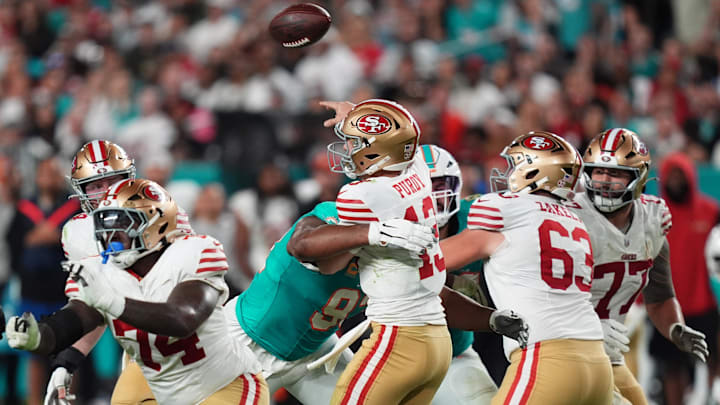It's something fans witness every college and pro football game without ever really seeing.
With Pro Ducks Dillon Gabriel and Bo Nix working in the NFL now, and 6-3, 210 Dante Moore gearing up to play quarterback for the Ducks, what does a quarterback actually experience in the pocket in real time during a game?
The "Coach Yac" podcast set out to explore this question with 49ers quarterback Brock Purdy (6-1, 220) in a recent interview posted on X.
Yac asked, "You're going to run a seam. Deebo's going to run a seam. What do you see? Can you see that he's actually open?"
Yac elaborated. "Help me out here, because it doesn't make any sense to me. You're six-foot, whatevery-you-are, everybody in front of you is a foot taller than everybody on the planet, hands are in the air. The angle we get, it looks like, 'oh god, he had a step.'"
"But if you're 40 yards away, on the ground, looking through 20 other people. What do you SEE to release that ball? Or do you know it's 50-50 and you're just gonna try and put it in the right place?"
Purdy, in his fourth year in the league with San Francisco after starting four years at Iowa State, ducks 6-7, 320 tacklers every Sunday but he didn't duck the question.
"My quarterback coach Brian Griese, the last couple of years, he and talked about that. He played 11 years. His dad's Bob Griese. Really, it's 60-40. You can see about 60 percent and the other 40 percent you really can't."
"I mean it doesn't matter how big you are. I'm already shorter in stature, yes, but that's why it's so important, knowing coverages, knowing scheme, where our players are supposed to be, how many steps they're breaking and where the ball should be over a certain backer. All those things, man, it matters."
Occasionally a window breaks and a quarterback gets a wide-open view of the play in front of him, but most of the time he has to process from incomplete information at high speed while large, athletically gifted men are trying to drive 320 pounds into his sternum. It's an atmosphere of complete mayhem.
Brock Purdy says about 40% of the time he’s not able to see his intended target on throws downfield due to the size of the linemen in front of him (which is typical for most QBs who aren’t very tall). He talks about how important it is knowing coverages, scheme, and knowing where… pic.twitter.com/2p6IwcuNZr
— Coach Yac 🗣 (@Coach_Yac) March 27, 2025
Even for a tall quarterback like 6-6 Justin Herbert or Oregon Duck freshman Akili Smith Jr., it's chaos that requires meticulous study, elite processing speed and complete trust in your ability and your teammates.
But every time Moore or Dillon Gabriel or any other shorter QB has a pass batted down or intercepted, commentators or fans in the stands will mention his height, questioning his poise, vision and decision-making. Worse yet, his courage and intelligence.
Outside of hitting a baseball, it's the toughest job in sports. That's why they make millions in the pros, increasing amounts in the college game.
